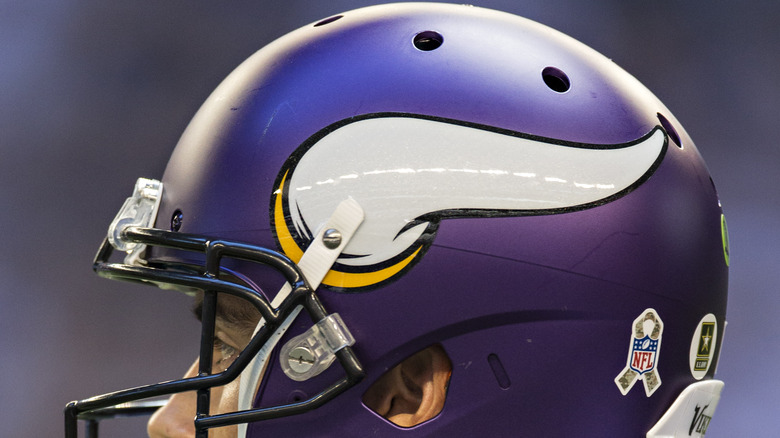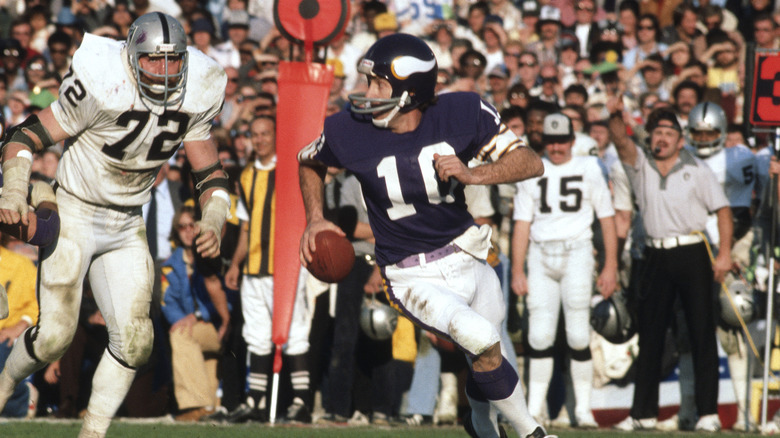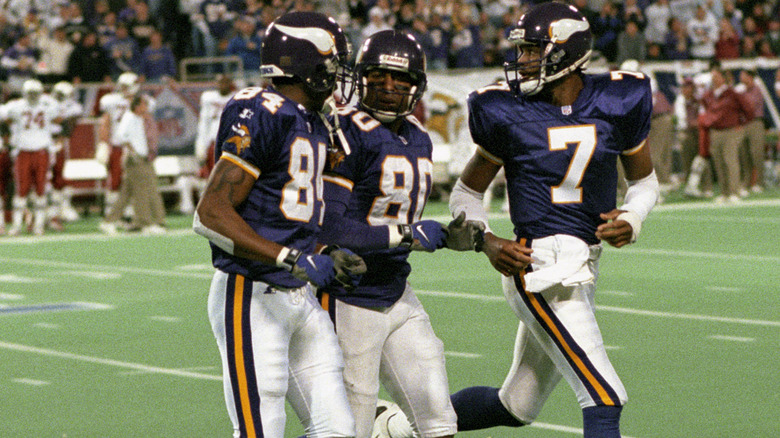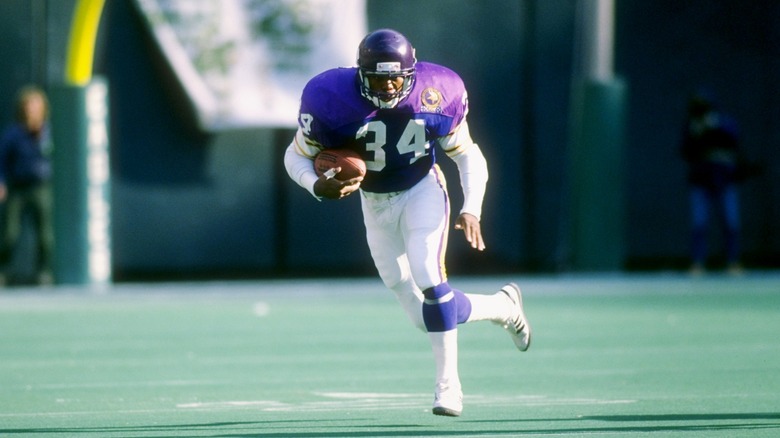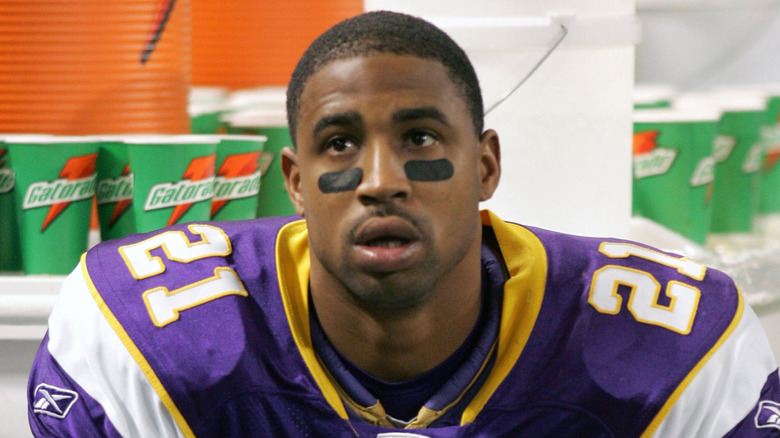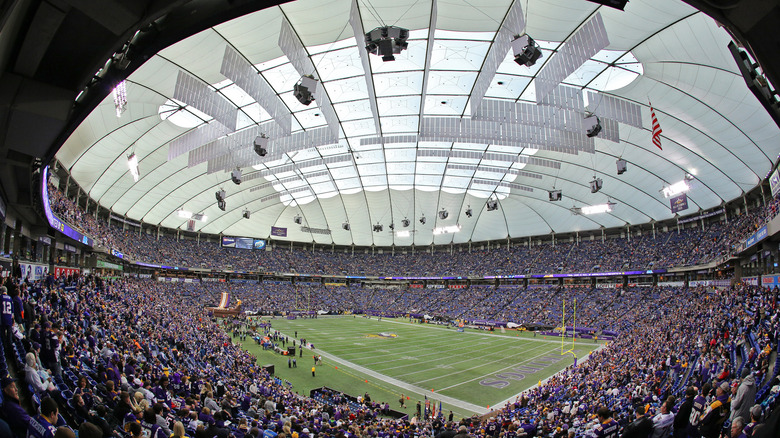Tragic History Of The Minnesota Vikings
Since entering the National Football League in 1961, the Minnesota Vikings have been one of the most celebrated franchises in all of professional football. According to Britannica, the Vikings have featured some of the greatest and most influential players in the sport's history in just their first decade of existence. Longtime Vikings quarterback, Fran Tarkenton, innovated the game by being one of the first scrambling quarterbacks to find success in the game, setting the stage for modern players such as Aaron Rodgers and Patrick Mahomes. According to their website, defensive end Alan Page became the first defensive player to win the league's highest honor, the Most Valuable Player trophy, in 1971.
Over the next half-century, the Vikings would continue to boast some of the greatest players in all of pro football. However, they also have been one of the most snake-bitten franchises in the sport, failing to achieve the sport's greatest accomplishment, a Super Bowl trophy. According to Statmuse, Minnesota is only one of four franchises with four Super losses. Despite all the talented Vikings teams that have stepped onto the field week in and week out, Minnesota has failed to reach the Super Bowl since the 1970s. Ironically, Minnesota's stadium has hosted two Super Bowls, but their team has come up just short of reaching the Super Bowl, most recently in 2018 when they fell to the eventual Super Bowl champions Philadelphia Eagles in the Conference Championship game. Another heartbreaking moment in the tragic history of the Minnesota Vikings.
The Vikings lost four Super Bowls in eight years
It is not surprising to see teams first entering professional leagues to struggle for a period of time. These new teams are young, and any veterans of their roster are castoffs from other teams. It takes years for new teams to finally reach the same level as the rest of the league. According to their official website, the Vikings, who officially came into existence on January 28, 1960, were playing for the championship almost exactly a decade later.
On January 11, 1970, the Vikings squared off against the Kansas City Chiefs in Super Bowl IV. According to "NFL's Top 10 Upsets," the Vikings were the overwhelming favorite. In a surprising turn of events, Kansas City dominated Minnesota and won 23-7. Four years later, Minnesota returned to the Super Bowl to face the Miami Dolphins, who defeated Minnesota 24-7. The Vikings returned a year later, only to fall to the Pittsburgh Steelers 16-6. Not only did Pittsburgh hand Minnesota its third Super Bowl loss, Pittsburgh also set defensive records, holding the Vikings' offense to a Super Bowl low in total yards (102) and yards per carry (0.8 YPC), 24/7 Sports reports.
Two years later, the elder Vikings had one last bite at the apple against the Oakland Raiders in Super Bowl XI. Minnesota scored a franchise record 14 points in the game. Unfortunately, Oakland scored 32 points in a blowout victory. This remains the last Super Bowl appearance by any Vikings team.
A rise to the top but no Super Bowl
Two decades after their last defeat in the Super Bowl, the 1998 Minnesota Vikings had a team arguably greater than any Vikings team prior. The NFL ranked them No. 38 on their list of the "100 Greatest Teams," ahead of many teams who won the Super Bowl. The strength of the 1998 Vikings was their historic offense that averaged 35 points per game and scored a then-record 556 total points, as told by Statmuse.
According to Bleacher Report, the Vikings sent a league-high, 10 players to the Pro Bowl. One of the players was a rookie wide receiver named Randy Moss. Moss had fallen in the NFL Draft because of the off-the-field issues while at Marshall University, but Vikings head coach Dennis Smith believed in Moss' potential and that veteran wide receiver Cris Carter could mentor the youth. His gamble paid off, and Moss and Carter became football's most feared tandem. Coupled with the re-emergence of quarterback Randall Cunningham and a strong defense, Minnesota hosted the Atlanta Falcons in the Conference Championship game for an opportunity to compete in the Super Bowl.
In the game's final minutes, Vikings kicker Gary Anderson missed his first field goal of the season that would have driven the metaphorical nail in Atlanta's coffin. The Falcons capitalized off the miss, tied the game, and kicked their own game-winning field goal in overtime to send them to the Super Bowl. Falcons 30, Vikings 27.
The Hershel Walker trade led to the Dallas Cowboys dynasty
In 1989, the Minnesota Vikings were knocking at the door of a championship. As told by their official page, the Vikings had appeared in back-to-back postseasons, only to fall in the playoffs. Desperate to take the final step, the team made a trade in October 1989 for the star running back of the Dallas Cowboys Herschel Walker.
To say the trade was complicated is to put it lightly. According to ESPN, New York Giants general manager George Young said, "the trade agreement may be longer than the Magna Carta." On October 12, 1989, Dallas traded Walker for five Vikings players and six draft picks, as told by Bleacher Report. At the time, Dallas was 0-5 and on their way to winning only one game in a dreadful season. Head coach Jimmy Johnson and owner Jerry Jones looked to rebuild their team through the draft so, as a condition to the trade, all five players Dallas received came with a condition that they would be substituted for a draft pick if the player was no longer on the roster before 1990, Fox Sports reported.
Walker would spend three seasons in Minnesota and never live up to his expectation, as the Vikings never sniffed the Super Bowl. Dallas would take the picks and fill their roster with young talent, like Walker's replacement, Emmitt Smith, who would retire the all-time leading rusher. The Cowboys would win three Super Bowls between 1991 and 1996.
The Minnesota boat party scandal
In October 2005, the Minnesota Vikings made national headlines for something more out of Playboy than a playbook. According to ESPN, around 17 players for the Minnesota Vikings attended a party on two rental boats on Lake Minnetonka that, as detailed by a cruise staff member, had "excessive drinking, lewd public sexual acts, and other inappropriate behavior." Eventually, four players would be charged with three misdemeanors, indecent conduct, disorderly conduct, and lewd or lascivious conduct.
The players charged were quarterback Dante Culpepper, offensive tackle Bryant McKinnie, running back Moe Williams, and defensive back Fred Smoot, who, by his own words, was the "boat captain" of the party. Speaking to Barstool in 2018, Smoot recounted the planning of the party. Smoot said it was a traditional rookie party for players. However, the club they usually attended had shut down, so Smoot rented two boats for the gathering. Around 55 women from around the country flew into Minnesota, who Smoot said were strippers. Details of the acts at the party embarrassed Vikings' owner Zygi Wilf, who lambasted the team's conduct when the news broke.
Smoot, McKinnie, and Williams would plead guilty for disturbing the peace and were handed down fines and community service. The charges against Culpepper's were dropped. The Vikings would miss the postseason and fire head coach Mike Tice after the season, 12 Up reports. Many looked at the "Love Boat Scandal" as the beginning of the end for Tice's tenure.
Their stadium collapsed five times
Seeing that professional football is played during the autumn and winter months and traditionally played outdoors, it is common to see games in sub-freezing temperatures or while a blizzard is occurring. During the Viking's most successful years in the 1970s, the team played outdoors and, as explained by NFL Films, head coach Bud Grant used the weather as a psychological advantage.
According to their official website, Minnesota's days playing in the snow ended following the 1981 season, when they moved into the Hubert H. Humphrey Metrodome. In a heat-controlled dome, the cold-field advantage ended for Minnesota, but this did not mean that bad weather had no effect on Vikings games.
According to Sportscasting, the roof of the stadium collapsed four times during the 1980s alone! The first time was in 1981 when a heavy snowstorm weighed down the Teflon and fiberglass roof until it gave in. The Vikings shared the dome with their baseball counterparts, the Minnesota Twins. However, the Metrodome was far from ideal for the baseball team. By the mid-1990s, the team was already looking for a new home. It would not be until 2010 when the Twins moved from the Metrodome to Target Field. That same year, the Metrodome collapsed a fifth and final time. In December 2010, another heavy snowstorm weighed down the roof and collapsed it. The difference from the other collapses was the fall was captured on video.
